POLONNARUWA - INSIDER
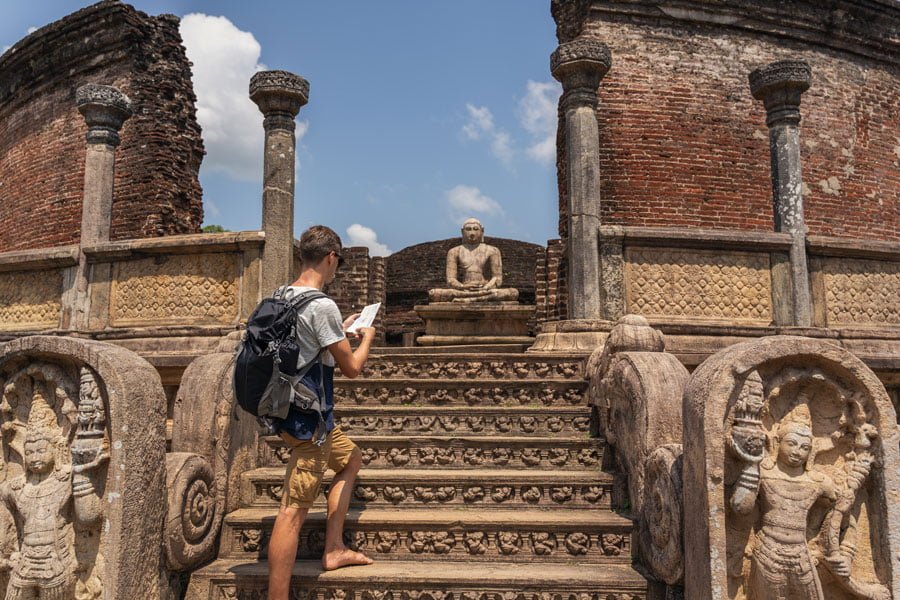
Polonnaruwa is a historical city located in the North Central Province of Sri Lanka, about 216 km from Colombo. It was the second capital of Sri Lanka after Anuradhapura and is now a UNESCO World Heritage Site, known for its well-preserved ancient ruins and archaeological sites.
Polonnaruwa was the capital of Sri Lanka during the 11th and 12th centuries and was a center of political, religious, and cultural development. The city is known for its impressive architecture, including the royal palace, the council chamber, and several temples and stupas. The ruins of the city provide a glimpse into the ancient civilization of Sri Lanka and are a must-visit for history buffs and cultural enthusiasts.
The ruins of Polonnaruwa include several temples, stupas, statues, and other structures, many of which are still in remarkable condition despite being over 1,000 years old. The city is also known for its irrigation system, which was designed to provide water for agriculture and helped the city to prosper.
Visitors to Polonnaruwa can explore the ruins by foot or bicycle, and there are several sites that are particularly worth seeing, including the Royal Palace, the Gal Vihara, the Lankatilaka Temple, and the Parakrama Samudra lake.
Overall, Polonnaruwa is an incredible destination that offers a glimpse into Sri Lanka’s rich history and culture, and it’s a must-visit for anyone interested in archaeology, ancient civilizations, or cultural tourism.
Enjoy the best of this tropical paradise on a short tour.
Attractions & Places to visit in POLONNARUWA

-
SHIVA TEMPLE
-
ARCHAEOLOGICAL MUSEUM
-
ROYAL PALACE
-
GAL VIHARA
-
VATADAGE
-
LANKATILAKA TEMPLE
-
THUPARAMA
-
RANKOT VIHARA
-
KIRI VIHARA
-
NISSANKA LATHA MANDAPAYA
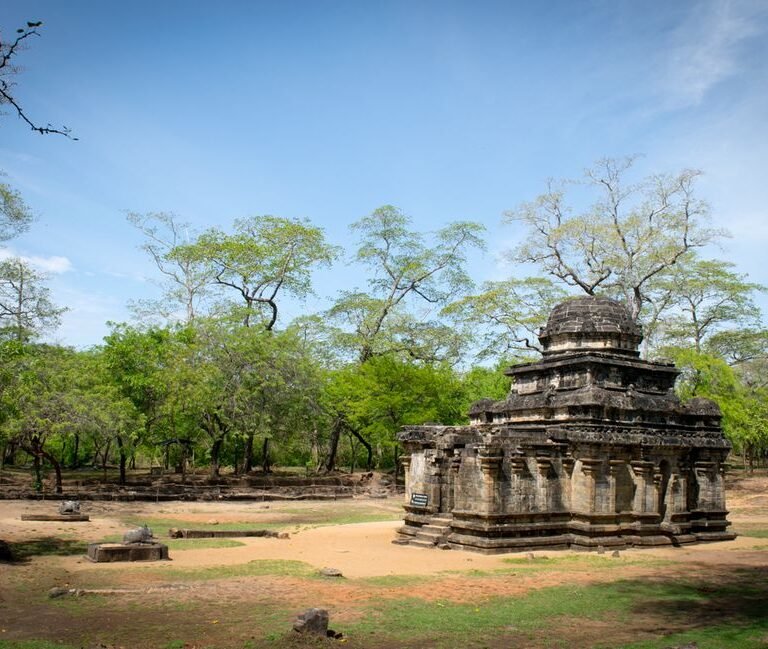
The Polonnaruwa Shiva Temple, also known as the Polonnaruwa Siva Kovil, is a Hindu temple located in the ancient city of Polonnaruwa, which is now a UNESCO World Heritage Site in Sri Lanka. The temple is dedicated to Lord Shiva and is considered one of the most important Hindu temples in Sri Lanka.
The temple dates back to the 11th century, during the reign of King Vijayabahu I, and was built to commemorate his victory over the Chola invaders. The temple was further expanded and renovated by subsequent kings, including Parakramabahu I and Nissanka Malla.
The main feature of the temple is the Shiva Lingam, a sacred symbol of Lord Shiva, which is enshrined in the sanctum sanctorum of the temple. The temple also has several other deities, including Lord Ganesha, Lord Murugan, and Goddess Parvati.
The temple is known for its intricate carvings and sculptures, which depict various scenes from Hindu mythology. The temple also has a sacred pond called Siva Gangai, which is believed to have healing powers.
Today, the Polonnaruwa Shiva Temple is an important pilgrimage site for Hindus in Sri Lanka and attracts a large number of visitors every year.
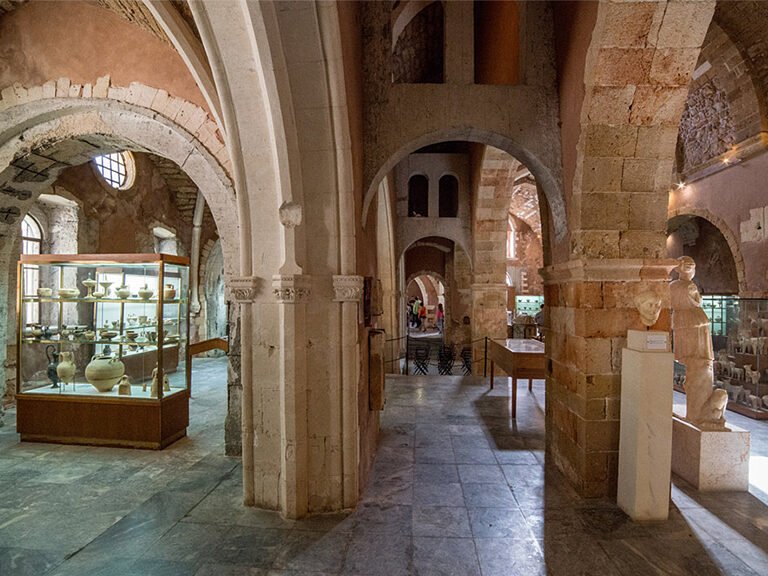
The Archaeological Museum in Polonnaruwa is a museum dedicated to preserving and showcasing the ancient artifacts and archaeological finds of the Polonnaruwa Kingdom, which was a major kingdom in Sri Lanka between the 11th and 13th centuries.
The museum was established in 1962 and is located within the ancient city of Polonnaruwa, which is now a UNESCO World Heritage Site. The museum's collection includes a wide range of artifacts, including statues, sculptures, pottery, coins, and other archaeological finds.
One of the museum's highlights is the Gal Vihara collection, which includes four large statues of Lord Buddha carved out of a single granite block. The museum also houses a collection of Hindu and Buddhist artifacts from the Polonnaruwa Kingdom, including images of Hindu deities such as Lord Vishnu and Lord Shiva.
In addition to the artifacts, the museum also provides visitors with information about the history and culture of the Polonnaruwa Kingdom, including its political and social structures, religious practices, and artistic traditions.
Overall, the Archaeological Museum in Polonnaruwa is a must-visit destination for anyone interested in Sri Lanka's rich cultural and archaeological heritage.
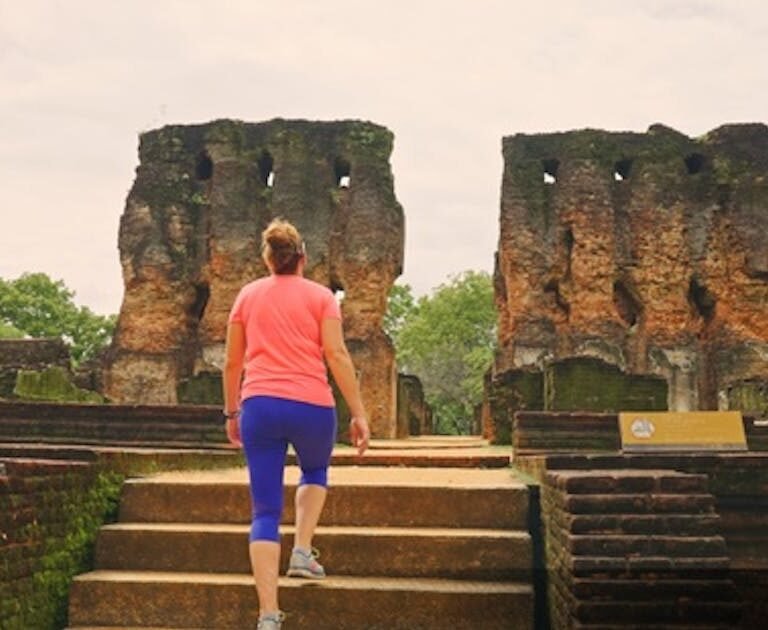
The Royal Palace of Polonnaruwa is a significant archaeological site located in the ancient city of Polonnaruwa in Sri Lanka. The palace complex dates back to the 12th century, during the reign of King Parakramabahu I, and is considered one of the most important and well-preserved examples of ancient Sri Lankan architecture.
The palace complex is located within a fortified enclosure and includes several structures, including the Royal Audience Hall, the Royal Bathing Pool, and the King's Council Chamber. The palace was built using traditional Sri Lankan architectural techniques, including the use of stone and brick for construction.
The Royal Audience Hall is the most impressive structure in the palace complex and is believed to have been used by the king for conducting court proceedings and receiving foreign dignitaries. The hall is supported by 30 stone pillars, which are intricately carved with images of lions, elephants, and other animals.
The Royal Bathing Pool, also known as the Kumara Pokuna, is another notable feature of the palace complex. The pool is divided into two sections and was used by the king and his queens for bathing and relaxation.
Today, the Royal Palace of Polonnaruwa is a popular tourist destination and attracts visitors from all over the world who are interested in learning about Sri Lanka's rich cultural heritage. The palace complex is a testament to the ingenuity and skill of the ancient Sri Lankan architects and is a must-visit destination for anyone interested in history and archaeology.

Gal Vihara is a Buddhist temple complex located in the ancient city of Polonnaruwa in Sri Lanka. It is known for its impressive rock sculptures of Lord Buddha, which are considered to be among the finest examples of ancient Sri Lankan sculpture.
The temple complex was built in the 12th century during the reign of King Parakramabahu I and is located within a walled enclosure. The Gal Vihara complex consists of four separate statues of Lord Buddha, all carved out of a single granite rock face.
The largest statue, known as the Standing Buddha, is 7 meters tall and depicts Lord Buddha in a posture of blessing. The second statue, known as the Seated Buddha, is 4 meters tall and shows Lord Buddha in a meditative posture. The third statue is a reclining Buddha, which is 14 meters long and shows Lord Buddha in a sleeping posture. The fourth statue is a smaller image of Lord Buddha in a seated posture.
The sculptures are notable for their remarkable detail and skillful craftsmanship, particularly the expressions on the faces of the Buddha statues. The complex is also surrounded by beautiful gardens and ponds, which add to its peaceful and serene atmosphere.
Today, Gal Vihara is an important pilgrimage site for Buddhists in Sri Lanka and attracts a large number of visitors every year. The complex is a testament to the rich cultural and artistic heritage of Sri Lanka and is a must-visit destination for anyone interested in history and archaeology.
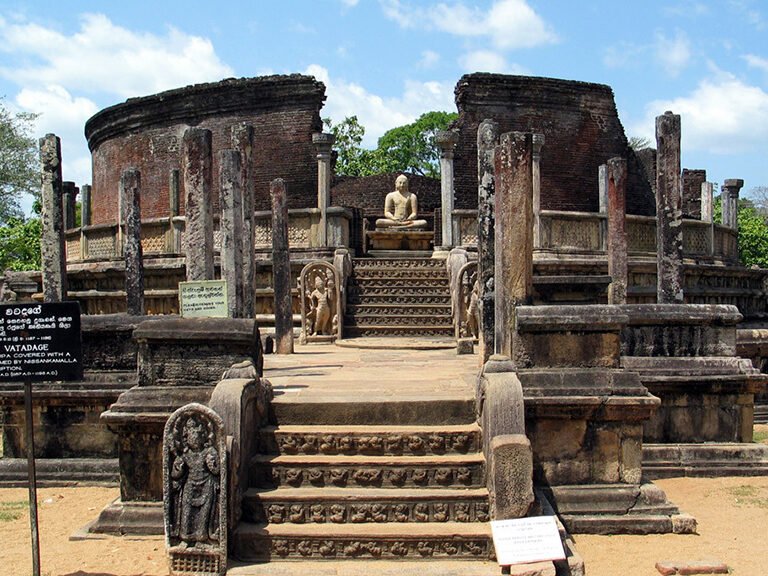
The Vatadage is located within the Sacred Quadrangle of the ancient city and was built to house the sacred Tooth Relic of Lord Buddha. The structure is circular in shape and is supported by a series of concentric stone columns. The outermost circle consists of 18 columns, each of which is intricately carved with images of lotus flowers and mythical beasts.
The innermost circle of the Vatadage contains a small shrine that was once home to the Tooth Relic of Lord Buddha. The shrine is surrounded by four large Buddha statues, each facing one of the four cardinal directions. The statues are made of stone and are believed to have been built during the reign of King Parakramabahu I.
The Vatadage is considered to be one of the finest examples of ancient Sri Lankan architecture and is a testament to the skill and creativity of the ancient Sri Lankan architects and craftsmen. It is also an important religious site for Buddhists in Sri Lanka and is visited by pilgrims from all over the world.
Today, the Vatadage is a popular tourist attraction and is recognized as a UNESCO World Heritage Site. It is a must-visit destination for anyone interested in Sri Lanka's rich cultural and architectural heritage.
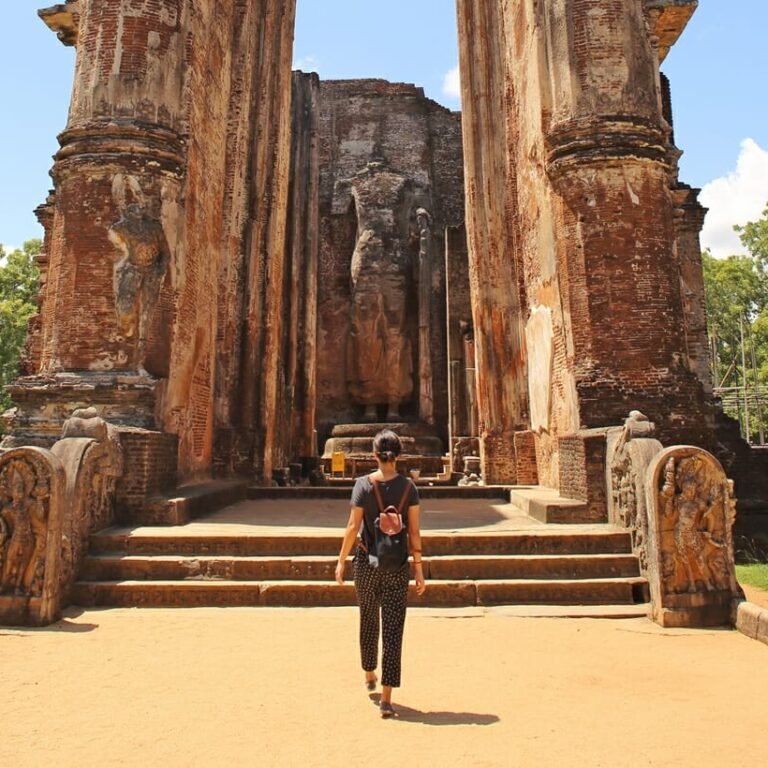
The Lankatilaka Temple is an ancient Buddhist temple located in the ancient city of Polonnaruwa in Sri Lanka. The temple was built in the 14th century by King Bhuvanekabahu IV and is considered to be one of the most impressive examples of ancient Sri Lankan architecture.
The temple is situated on a high rock outcrop and is surrounded by beautiful gardens and scenic views of the surrounding countryside. The temple's main structure is a large brick and stone building that features intricate carvings and decorations. The temple's most notable feature is its towering brick and plaster walls, which rise up to a height of 17 meters.
Inside the temple, visitors can admire a large statue of Lord Buddha that is believed to date back to the 15th century. The statue is seated in the traditional lotus posture and is surrounded by smaller statues of other Buddhist deities and figures.
The Lankatilaka Temple is also home to several other notable features, including a large image house that contains several well-preserved frescoes and a small library that houses ancient Buddhist texts and scriptures.
Today, the Lankatilaka Temple is a popular tourist destination and is recognized as a UNESCO World Heritage Site. It is a must-visit destination for anyone interested in Sri Lanka's rich cultural and architectural heritage and provides a fascinating glimpse into the country's ancient past.
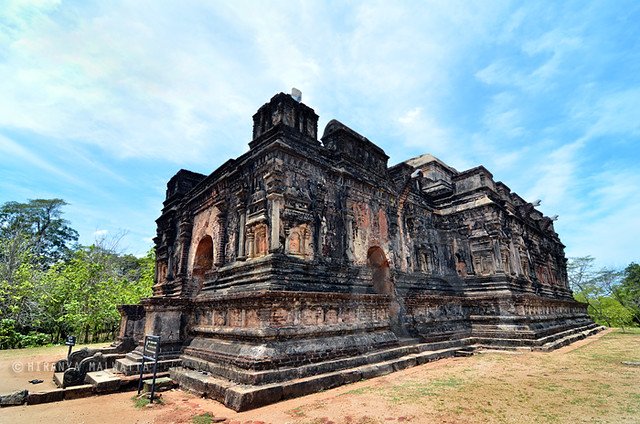
Thuparama is an ancient Buddhist temple located in the ancient city of Polonnaruwa in Sri Lanka. The temple is one of the most important historical and religious sites in the country and is a popular destination for tourists and pilgrims.
The Thuparama temple was built during the reign of King Parakramabahu I in the 12th century and is believed to have housed the sacred Tooth Relic of Lord Buddha. The temple is a relatively small structure compared to other temples in the area but is known for its intricate carvings and architectural beauty.
The temple's main structure is a square-shaped shrine room that is surrounded by a series of smaller rooms and halls. The shrine room contains a small stupa that is believed to contain a portion of the Tooth Relic of Lord Buddha. The stupa is surrounded by a series of beautifully carved pillars and statues of Lord Buddha and other Buddhist deities.
The Thuparama temple is also home to several other notable features, including a stone image house that contains several well-preserved Buddha statues and a small museum that displays artifacts and relics from the temple's rich history.
Today, the Thuparama temple is an important pilgrimage site for Buddhists in Sri Lanka and attracts a large number of visitors from around the world. It is a testament to the rich cultural and religious heritage of Sri Lanka and is a must-visit destination for anyone interested in history and archaeology.
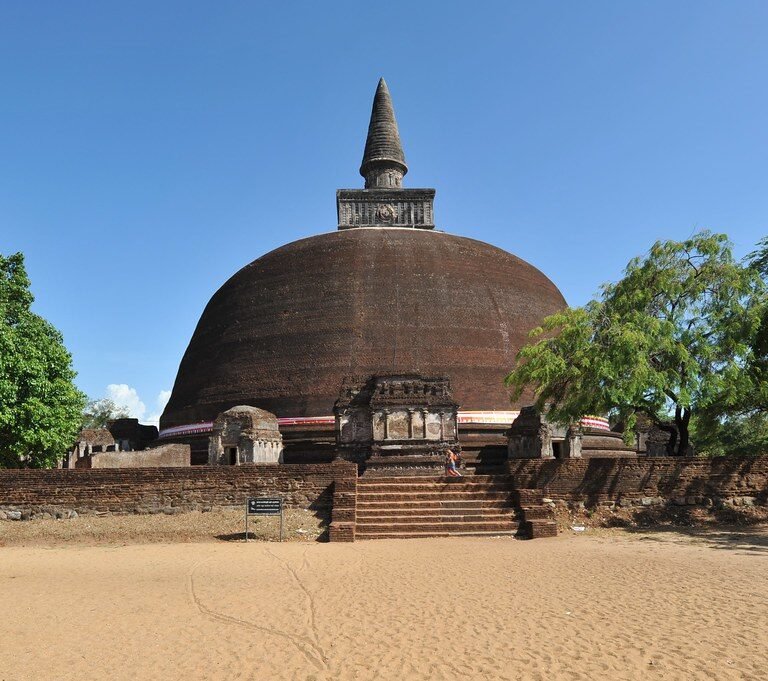
Rankot Vihara is an ancient Buddhist temple located in the ancient city of Polonnaruwa in Sri Lanka. It is the largest and most impressive of the many stupas (dome-shaped structures) in the city and is considered to be one of the finest examples of ancient Sri Lankan architecture.
The Rankot Vihara stupa was built during the reign of King Nissanka Malla in the 12th century and is believed to have been used as a place of worship and meditation by the ancient monks who lived in the area. The stupa is a massive structure that rises to a height of over 50 meters and is surrounded by a series of smaller stupas and shrines.
The stupa's base has a diameter of 165 feet and is adorned with intricate carvings and decorations. The stupa is also covered in a layer of white plaster, giving it a gleaming appearance that can be seen from miles away.
Inside the stupa, visitors can see a small chamber that is believed to have once housed a relic of Lord Buddha. The chamber is accessed by a small staircase that leads to a platform at the top of the stupa.
The Rankot Vihara stupa is surrounded by a series of beautiful gardens and is a popular destination for tourists and pilgrims. It is a testament to the skill and creativity of the ancient Sri Lankan architects and craftsmen and is a must-visit destination for anyone interested in Sri Lanka's rich cultural and architectural heritage.
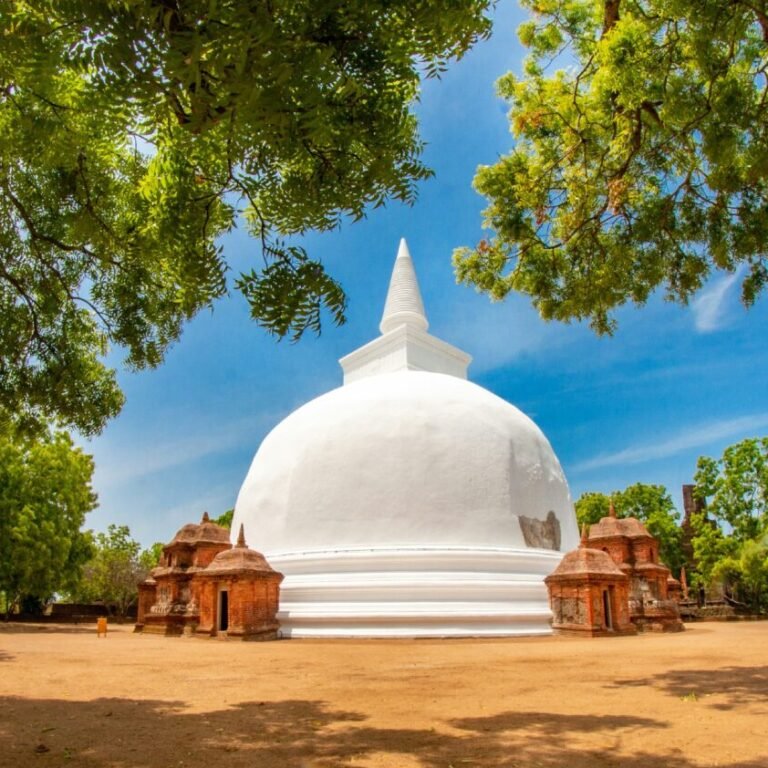
Kiri Vihara is an ancient Buddhist temple located in the ancient city of Polonnaruwa in Sri Lanka. The temple is one of the most important religious and historical sites in the country and is a popular destination for tourists and pilgrims.
The Kiri Vihara temple is believed to have been built during the reign of King Parakramabahu I in the 12th century and is one of the four major stupas in the city. The stupa is a relatively small structure compared to other stupas in the area, but is known for its unique architecture and beautiful decorations.
The Kiri Vihara stupa is a white-washed structure that rises to a height of approximately 40 meters. The stupa is surrounded by a series of smaller shrines and statues of Lord Buddha and other Buddhist deities. The stupa's base is adorned with intricate carvings and decorations, including scenes from Lord Buddha's life and teachings.
Inside the Kiri Vihara stupa, visitors can see a small chamber that is believed to have once housed a relic of Lord Buddha. The chamber is accessed by a small staircase that leads to a platform at the top of the stupa.
The Kiri Vihara temple is surrounded by beautiful gardens and is a popular destination for tourists and pilgrims. It is a testament to the rich cultural and religious heritage of Sri Lanka and is a must-visit destination for anyone interested in history and archaeology.
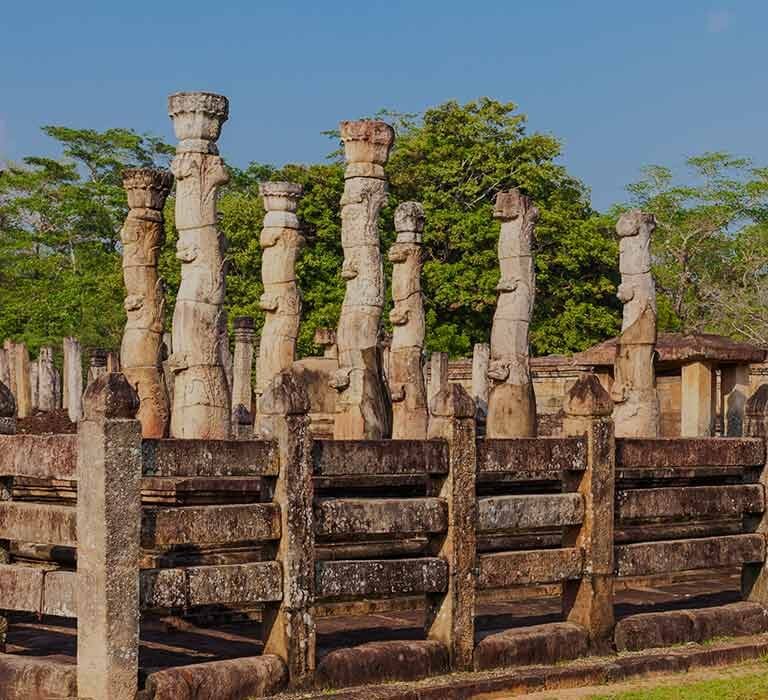
The Nissanka Latha Mandapaya is an ancient structure located in the ancient city of Polonnaruwa in Sri Lanka. It was built during the reign of King Nissanka Malla in the 12th century and is considered to be one of the most impressive examples of ancient Sri Lankan architecture.
The Nissanka Latha Mandapaya is a unique structure that was used as a ceremonial hall and gathering place for the ancient kings of Sri Lanka. It is an open-air pavilion that is supported by a series of carved stone pillars and decorated with intricate carvings and sculptures.
The pavilion's roof is adorned with a series of lotus petals, which are believed to symbolize purity and enlightenment in Buddhist culture. The pillars are also decorated with carvings of lotus flowers, as well as other symbols and figures from Buddhist mythology.
The Nissanka Latha Mandapaya is located within the grounds of the ancient royal palace in Polonnaruwa and is a popular destination for tourists and history enthusiasts. It is a testament to the creativity and skill of the ancient Sri Lankan architects and craftsmen and is a must-visit destination for anyone interested in Sri Lanka's rich cultural and architectural heritage.
THERE IS SO MUCH YOU CAN DO
TOP THINGS TO DO IN POLONNARUWA

-
CYCLING ANCIENT CITY OF POLONNARUWA
-
VISIT TEMPLES
-
ARCHAEOLOGICAL RELIC
-
WILDLIFE SAFARI
-
VISIT PARAKRAMA SAMUDRA
-
VISIT ARCHAEOLOGICAL MUSEUM
-
HIKING
-
ANGAMMEDILLA NATIONAL PARK
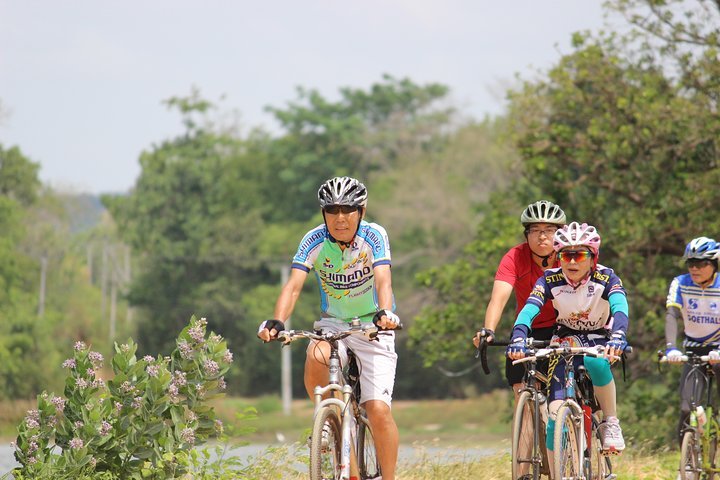
Cycling through the ancient city of Polonnaruwa is a popular way to explore the many historical and cultural sites in the area. The city is known for its well-preserved ruins of palaces, temples, and stupas, and cycling is an excellent way to get up close and personal with these ancient structures.
Many tourists rent bicycles from local shops or their hotels and take a self-guided tour of the city. The route typically takes visitors through the various sites in the area, including the Royal Palace, the Gal Vihara, the Vatadage, and the Rankot Vihara. Along the way, visitors can stop to explore the temples and take in the beautiful scenery of the surrounding countryside.
Cycling is a fun and eco-friendly way to explore the ancient city, and it allows visitors to go at their own pace and stop wherever they choose. The roads in the area are generally flat and well-paved, making it an easy ride for people of all fitness levels.
Visitors should be sure to wear comfortable clothing and bring plenty of water and sunscreen, as the weather in the area can be hot and humid. They should also be respectful of the ancient sites and avoid damaging any of the structures

Polonnaruwa is home to many ancient temples, each with their own unique history and architectural features. Some of the most popular temples to visit in the area include:
Gal Vihara - This temple is famous for its four giant Buddha statues, carved from a single piece of granite rock. The statues are considered to be some of the finest examples of ancient Sri Lankan rock carving.
Vatadage - This circular temple was built in the 12th century and is considered to be one of the most sacred places in Polonnaruwa. It features four entrances, each leading to a statue of the Buddha.
Lankatilaka Temple - This temple is known for its massive brick walls and towering Buddha statue. It was built during the reign of King Parakramabahu I and is considered to be one of the finest examples of ancient Sri Lankan architecture.
Thuparama - This temple was built in the 12th century and is home to a large statue of the Buddha. It is considered to be one of the most well-preserved temples in Polonnaruwa.
Kiri Vihara - This small white-washed stupa is a unique example of Sri Lankan stupa architecture. It is believed to have been built during the reign of King Parakramabahu I and is considered to be one of the most important religious sites in Polonnaruwa.
Visitors should be sure to dress appropriately when visiting temples in Polonnaruwa, covering their shoulders and legs out of respect for the religious significance of the sites. They should also be respectful of the ancient structures and avoid touching or damaging any of the carvings or sculptures.
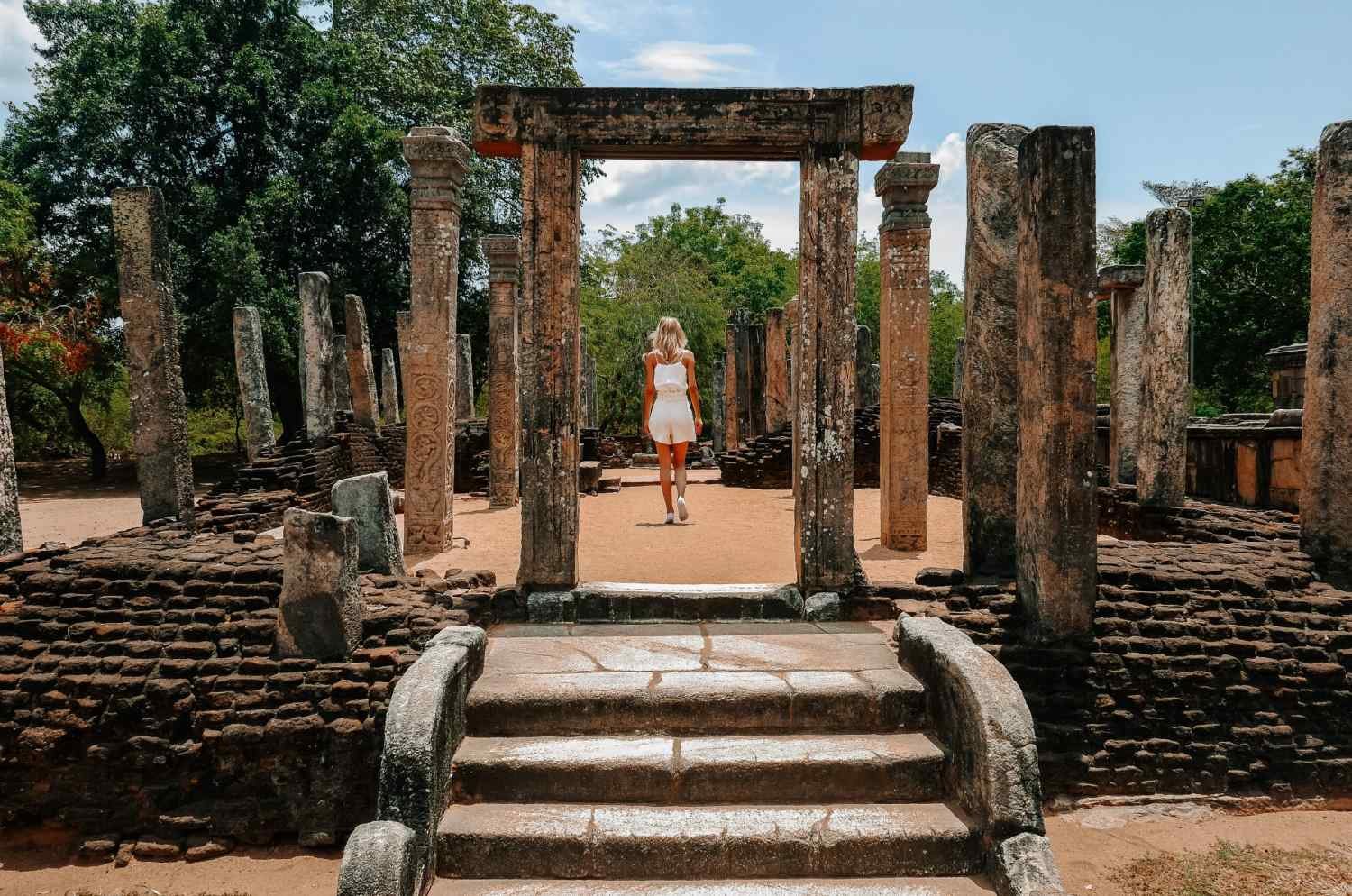
Polonnaruwa is a city rich in archaeological relics, with many ancient structures and artifacts that have been well-preserved over the centuries. Some of the most notable archaeological relics in the area include:
The Royal Palace - This impressive structure was the residence of the Sri Lankan kings during the height of the Polonnaruwa kingdom. Although much of the palace has been destroyed, visitors can still see the remains of its massive walls and intricate carvings.
Gal Vihara - This temple is home to four impressive Buddha statues, carved from a single piece of granite rock. The statues are considered to be some of the finest examples of ancient Sri Lankan rock carving.
Rankot Vihara - This ancient stupa is one of the largest in Sri Lanka and is believed to date back to the 12th century. It stands at an impressive 55 meters tall and is surrounded by a massive wall.
Nissanka Latha Mandapaya - This open-air pavilion was used as a ceremonial hall and gathering place for the ancient kings of Sri Lanka. It is supported by a series of carved stone pillars and decorated with intricate carvings and sculptures.
Thuparama - This temple is home to a large statue of the Buddha and is considered to be one of the most well-preserved temples in Polonnaruwa. It also features a number of interesting carvings and sculptures.
These archaeological relics offer a glimpse into the rich history and culture of Sri Lanka's ancient civilizations and are a must-see for visitors to Polonnaruwa. Visitors should be respectful of the ancient structures and avoid touching or damaging any of the carvings or sculptures. They should also be sure to follow any posted rules or regulations at the archaeological sites.
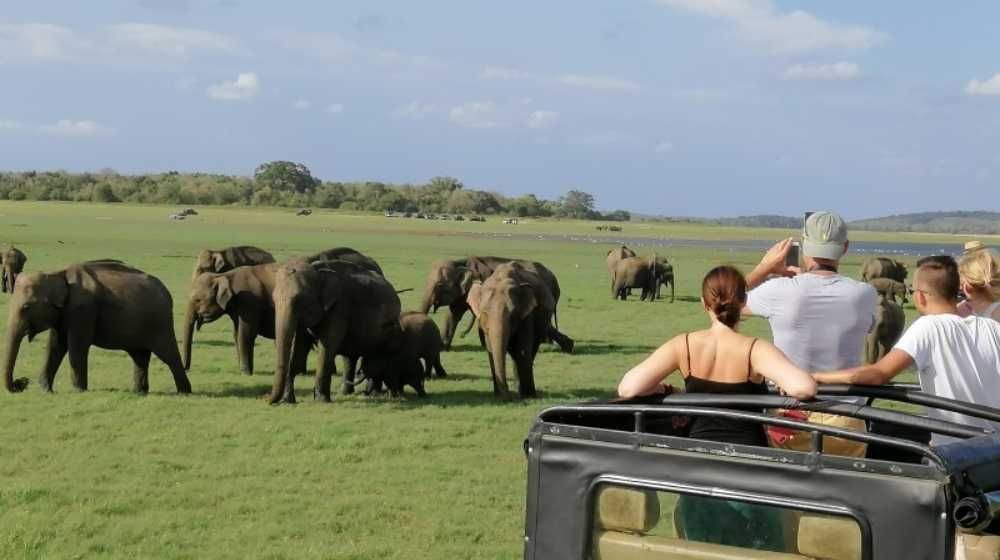
While Polonnaruwa is primarily known for its ancient ruins and temples, there are also some opportunities to experience the region's wildlife on a safari. Here are some of the best places for a wildlife safari in Polonnaruwa:
Minneriya National Park - Located just a short distance from Polonnaruwa, Minneriya National Park is home to a variety of wildlife including elephants, leopards, sambar deer, and several species of birds. One of the park's main attractions is the annual gathering of elephants, known as "The Gathering," which takes place between July and October.
Kaudulla National Park - This national park is located about 20 km from Polonnaruwa and is home to a large population of elephants. Visitors can also spot sambar deer, leopards, and a variety of bird species on a safari through the park.
Hurulu Eco Park - This park is located about 40 km from Polonnaruwa and is home to a variety of wildlife, including elephants, deer, jackals, and crocodiles. The park is also home to several bird species, making it a great spot for birdwatching.
Wasgamuwa National Park - Located about 75 km from Polonnaruwa, Wasgamuwa National Park is known for its large population of elephants, as well as its diverse birdlife. Visitors can also spot sloth bears, leopards, and several species of deer on a safari through the park.
A wildlife safari is a great way to experience the natural beauty and biodiversity of Sri Lanka's ancient kingdoms. Visitors should book their safari with a reputable tour operator and follow all rules and regulations in the parks to ensure the safety and well-being of the wildlife.
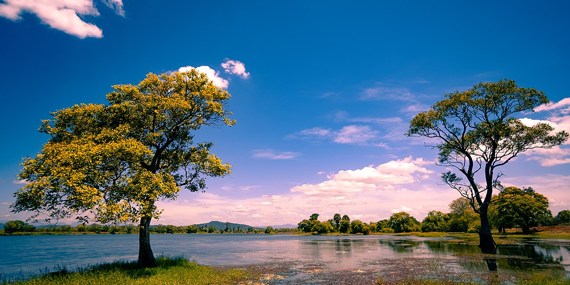
Parakrama Samudra, also known as the Sea of Parakrama, is a massive man-made reservoir located in Polonnaruwa. It was built during the reign of King Parakramabahu I in the 12th century and is considered to be a remarkable engineering feat of the ancient world. Here's what you need to know about visiting Parakrama Samudra:
Location - Parakrama Samudra is located about 4 km from the city center of Polonnaruwa. Visitors can easily reach the reservoir by car, tuk-tuk or bicycle.
Activities - Visitors can enjoy a boat ride on the reservoir, which offers a unique perspective of the surrounding landscape and wildlife. The area around Parakrama Samudra is also great for birdwatching, and visitors may spot a variety of bird species including pelicans, cormorants, and egrets.
History - Parakrama Samudra is a significant historical site and is closely linked to the ancient history of Sri Lanka. The reservoir was built by King Parakramabahu I to serve as a source of irrigation for the surrounding farmland, and it is still used for agriculture today.
Scenic Views - The reservoir offers breathtaking views of the surrounding landscape, especially during sunrise and sunset. Visitors can enjoy a peaceful walk along the reservoir's banks and take in the stunning scenery.
Wildlife - Parakrama Samudra is home to a variety of wildlife, including crocodiles, monitor lizards, and several species of fish. Visitors should be cautious and avoid getting too close to the water's edge.
Visiting Parakrama Samudra is a must-do activity for visitors to Polonnaruwa. It offers a glimpse into the region's rich history and natural beauty, and is a great spot for relaxation and reflection.
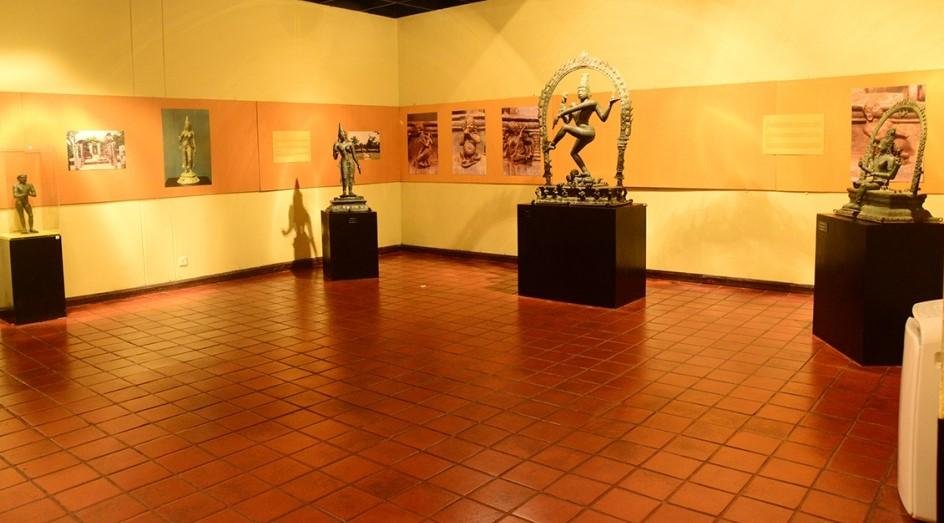
The Archaeological Museum in Polonnaruwa is a great place to learn about the ancient history and culture of Sri Lanka's second capital city. Here's what you need to know about visiting the Archaeological Museum in Polonnaruwa:
Location - The Archaeological Museum is located in the city center of Polonnaruwa, near the entrance to the ancient city.
Hours of operation - The museum is open from 8:30 am to 4:30 pm daily, except on public holidays.
Exhibits - The museum houses a collection of artifacts and exhibits related to the ancient history of Polonnaruwa. Visitors can see ancient pottery, coins, jewelry, and sculptures, as well as learn about the daily life and culture of the people who lived in the city.
Guided tours - Visitors can opt for a guided tour of the museum, which is recommended to fully appreciate the significance of the artifacts on display.
Entrance fee - There is an entrance fee to visit the Archaeological Museum. The fee is nominal, and discounts are available for students and children.
Photography - Photography is not allowed inside the museum.
Visiting the Archaeological Museum in Polonnaruwa is a great way to learn about the rich cultural heritage of the ancient city. The museum's exhibits provide valuable insights into the daily lives of the people who lived in the city, as well as the architecture and art of the time.

Polonnaruwa offers several hiking opportunities for visitors who enjoy outdoor activities. Here are some of the best hiking trails in Polonnaruwa:
Pothgul Viharaya Trail - This hiking trail starts at the Pothgul Viharaya temple and takes visitors through a scenic forest area. Along the way, visitors will pass several ancient ruins and temples, including the Hatadage, Thuparama and Vatadage temples.
Dimbulagala Trail - This hiking trail is located about 30 km from Polonnaruwa and takes visitors to the summit of Dimbulagala rock. The trail is steep and challenging, but the panoramic views from the top are well worth the effort.
Hiriwadunna Trail - This is a great hiking trail for visitors who want to experience rural Sri Lankan life. The trail takes visitors through rice paddies, vegetable gardens, and small villages, and ends at the scenic Hiriwadunna Lake.
Somawathiya Trail - This hiking trail is located about 50 km from Polonnaruwa and takes visitors to the ancient Somawathiya temple. The trail passes through a scenic forest area, and visitors may spot a variety of wildlife, including elephants, deer, and monkeys.
Minneriya Trail - This hiking trail takes visitors through the Minneriya National Park, which is known for its large population of elephants. Along the way, visitors may also spot other wildlife, including leopards, sloth bears, and sambar deer.
Before embarking on any hiking trails in Polonnaruwa, visitors should make sure to bring appropriate footwear, water, and sunscreen. It's also a good idea to go with a local guide who can provide valuable insights into the area's history and culture.
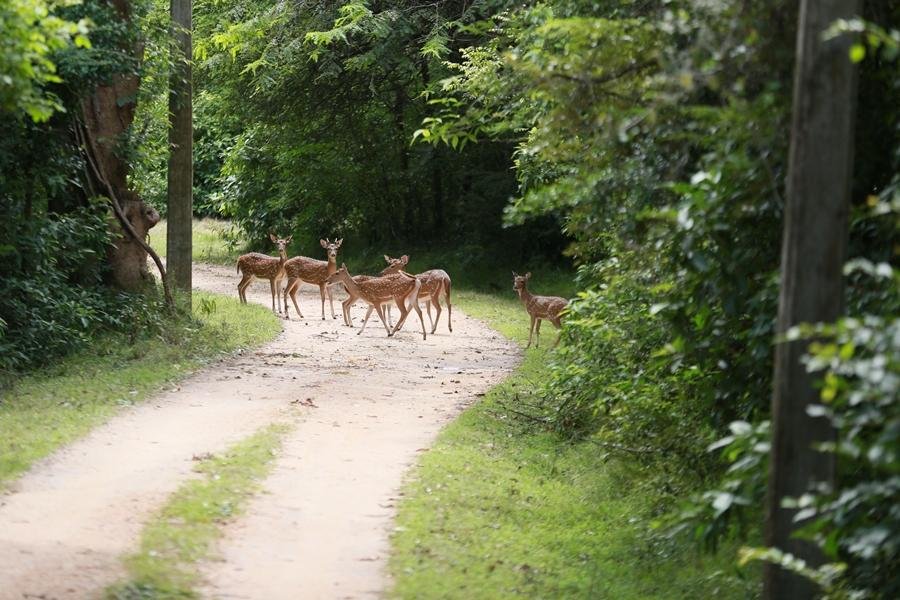
Angammedilla National Park is a national park located in the Central Province of Sri Lanka. It was established in 2006 and covers an area of approximately 4,400 hectares. The park is known for its rich biodiversity, with a variety of flora and fauna that can be found within its boundaries.
Some of the key species of fauna found in Angammedilla National Park include elephants, leopards, sloth bears, spotted deer, sambars, and wild boars. The park is also home to a number of bird species, including the Sri Lanka junglefowl, the Sri Lanka grey hornbill, and the Malabar pied hornbill.
The vegetation in the park is dominated by dry evergreen forests, which provide a habitat for a variety of plant species such as Ehela, Satin, Ebony, and Weera. The park also has a number of small lakes and water bodies, which are important sources of water for the wildlife in the area.
Visitors to Angammedilla National Park can enjoy a range of activities, including jeep safaris, birdwatching, and nature walks. The park is open year-round, but the best time to visit is from November to April when the weather is dry and sunny.
a journey through Sri Lanka's rich cultural heritage.
Discover the Ancient Serenity of TEMPLES
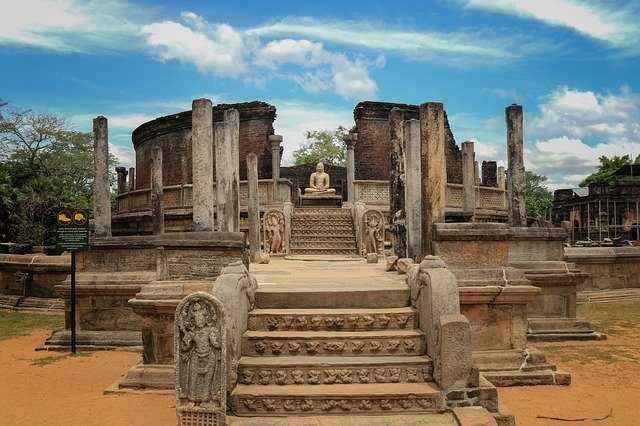
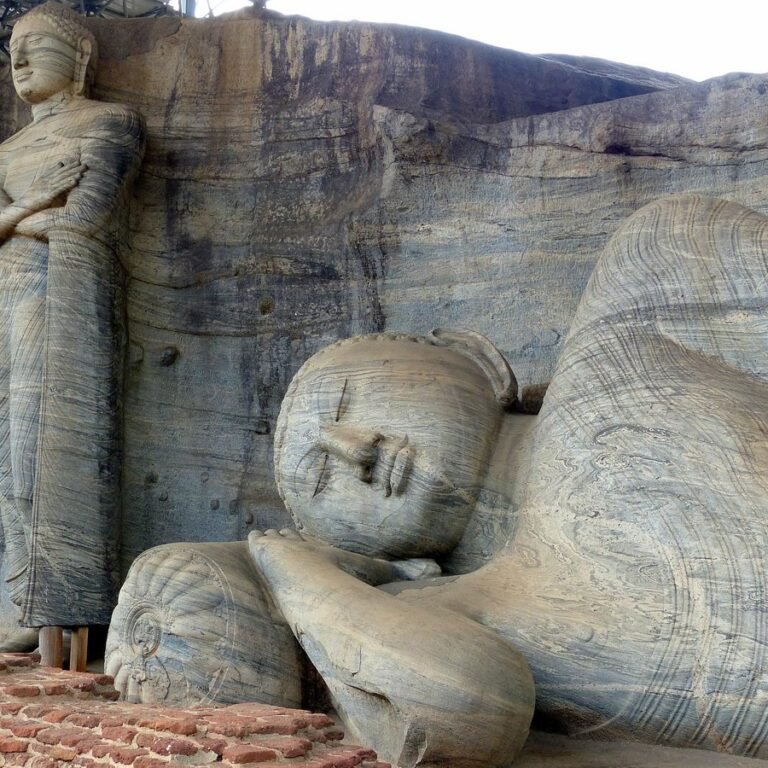
The Gal Vihara is a rock temple located in Polonnaruwa, a historical city in the North Central Province of Sri Lanka. It is a part of the ancient ruins of the city and is considered one of the most important landmarks of Polonnaruwa.
The Gal Vihara consists of four massive rock sculptures of Lord Buddha, which were carved into a granite boulder during the 12th century by King Parakramabahu I. The four statues are carved out of a single granite block and are said to represent the four postures of the Buddha - sitting, standing, reclining, and walking.
The most impressive of the four sculptures is the standing Buddha statue, which stands at a height of 7 meters and is considered one of the largest standing Buddha statues in the world. The other three sculptures are a seated Buddha statue, a reclining Buddha statue, and a walking Buddha statue.
The Gal Vihara is not only known for its magnificent rock sculptures but also for the intricate carvings that adorn the temple walls. The walls are decorated with beautiful carvings depicting scenes from the life of Lord Buddha, as well as other religious and mythological stories.
The Gal Vihara is a popular tourist attraction in Sri Lanka and attracts visitors from all over the world who come to admire the beautiful rock sculptures and the stunning carvings. It is a must-visit destination for anyone interested in the rich history and culture of Sri Lanka.
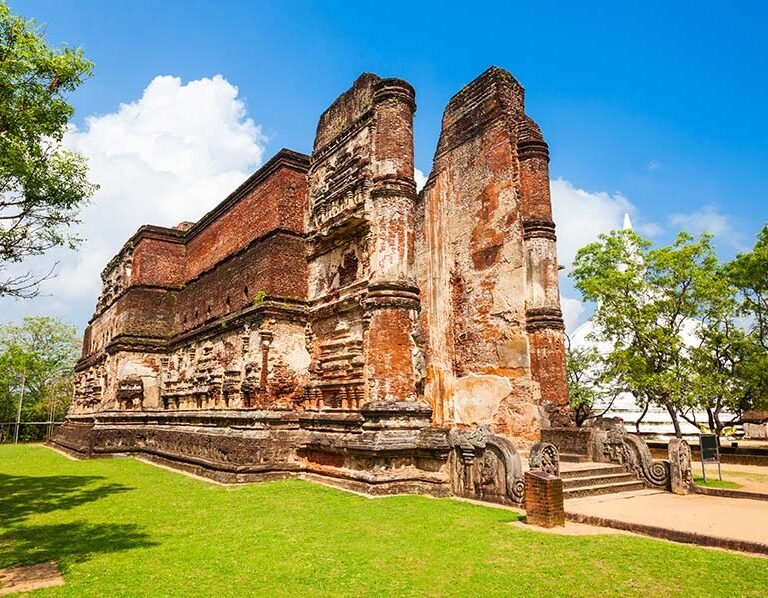
The Lankatilaka Temple is a Buddhist temple located in the ancient city of Polonnaruwa, in the North Central Province of Sri Lanka. It was built during the reign of King Parakramabahu I in the 12th century and is considered one of the finest examples of ancient Sinhalese architecture.
The temple is built on a high platform, and its most striking feature is its towering brick walls and intricate carvings. The main shrine room of the temple is a large, rectangular chamber with a high ceiling, and is surrounded by smaller rooms and courtyards.
The temple's walls are adorned with beautiful carvings depicting various scenes from Buddhist mythology and the life of Lord Buddha. The carvings are made from stucco and are painted in vibrant colors, giving the temple a unique and vibrant appearance.
The highlight of the Lankatilaka Temple is the massive statue of Lord Buddha, which stands at the center of the main shrine room. The statue is carved out of a single block of granite and stands at a height of over 40 feet, making it one of the largest Buddha statues in Sri Lanka.
Visitors to the Lankatilaka Temple can also explore the surrounding gardens, which are filled with exotic plants and flowers. The temple is a popular destination for both tourists and locals and is an important religious site for Buddhists in Sri Lanka.
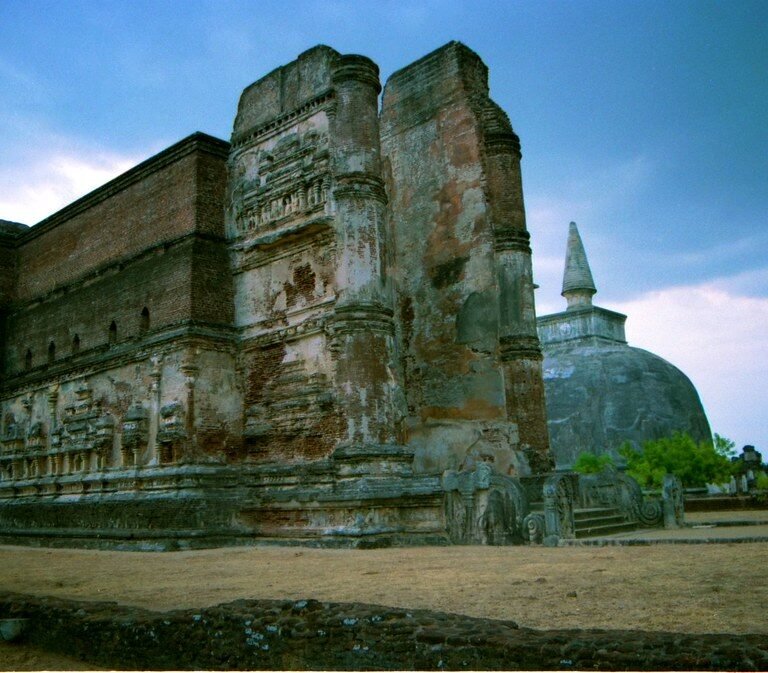
Rankoth Vehera is a stupa located in the ancient city of Polonnaruwa, in the North Central Province of Sri Lanka. It is one of the largest stupas in Polonnaruwa and is considered an important landmark of the city.
The stupa was built during the reign of King Nissanka Malla in the 12th century and stands at a height of 55 meters. It is built on a raised platform and is surrounded by a wall of stone pillars, which is adorned with carvings of lions and other animals.
The Rankoth Vehera is one of the most impressive structures in Polonnaruwa and is a testament to the architectural and engineering skills of the ancient Sinhalese. The stupa has survived numerous invasions and natural disasters over the centuries and remains one of the most important religious sites in Sri Lanka.
The stupa is surrounded by a number of smaller structures, including the Hatadage and the Atadage, which are believed to have been used as relic chambers. Visitors to Rankoth Vehera can climb to the top of the stupa for a breathtaking view of the surrounding area.
The stupa is also an important site for Buddhists, who come here to offer prayers and make offerings. It is particularly popular during religious festivals, when thousands of pilgrims flock to the site to pay their respects to Lord Buddha.
Overall, the Rankoth Vehera is a must-visit destination for anyone interested in the rich history and culture of Sri Lanka, and is a testament to the architectural and engineering achievements of the ancient Sinhalese.
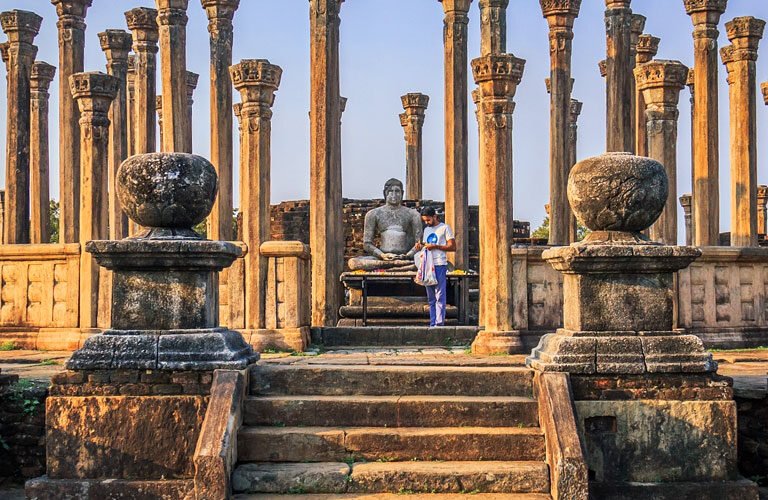
The Medirigiriya Vatadage is a circular relic house located in the ancient city of Medirigiriya, in the North Central Province of Sri Lanka. It is one of the best-preserved vatadages in Sri Lanka and is considered an important example of ancient Sinhalese architecture.
The vatadage is believed to have been built during the reign of King Kanittha Tissa in the 4th century AD, and was designed to enshrine a sacred relic of the Buddha. The structure consists of a circular chamber with four entrances, each guarded by two stone pillars.
The walls of the Medirigiriya Vatadage are adorned with beautiful carvings depicting various scenes from Buddhist mythology and the life of Lord Buddha. The carvings are made from granite and are intricately detailed, with delicate designs and motifs.
One of the most impressive features of the Medirigiriya Vatadage is the elaborate moonstone at the entrance. The moonstone is a circular stone slab with intricate carvings of lotus flowers and other designs, and is considered one of the finest examples of ancient Sinhalese art.
The Medirigiriya Vatadage is an important site for Buddhists in Sri Lanka, and is believed to be one of the earliest examples of a circular relic house in the country. The site is well-preserved and offers visitors a fascinating glimpse into the rich history and culture of Sri Lanka.
Overall, the Medirigiriya Vatadage is a must-visit destination for anyone interested in ancient Sinhalese architecture and Buddhist art. It is a testament to the skill and creativity of the ancient Sinhalese, and is a source of great pride for the people of Sri Lanka.
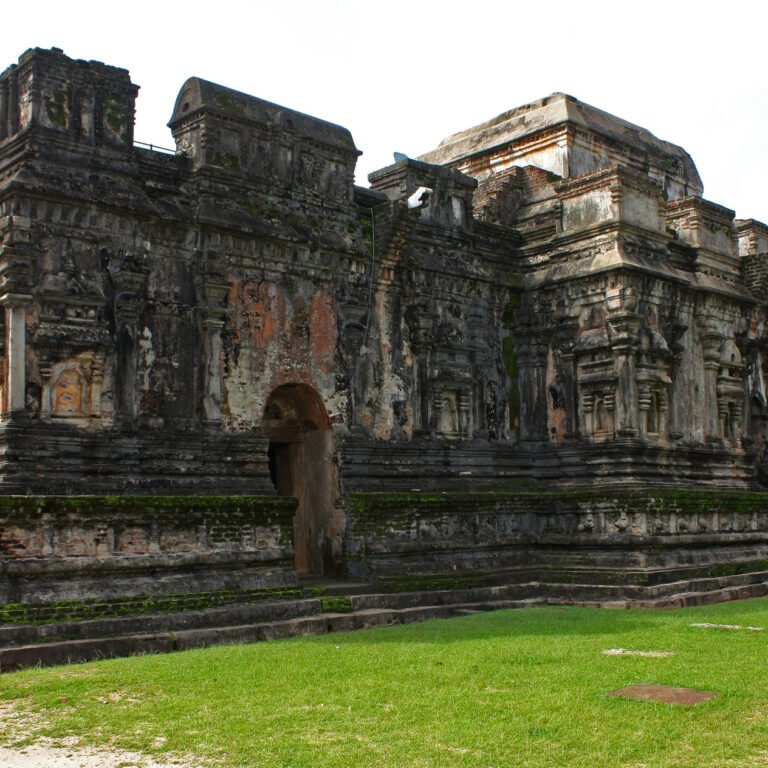
The Thuparama is a historical Buddhist temple located in Anuradhapura, a city in the North Central Province of Sri Lanka. It is believed to have been built by King Devanampiyatissa in the 3rd century BC, and is considered one of the oldest and most sacred temples in Sri Lanka.
The Thuparama is known for its magnificent stupa, which is believed to enshrine the right collarbone of Lord Buddha. The stupa is a massive structure, standing at a height of 20 meters, and is surrounded by a wall of stone pillars, which is adorned with carvings of elephants and other animals.
The temple complex also includes a number of smaller structures, including a small shrine room and a library, which contain important Buddhist texts and artifacts. Visitors to the Thuparama can also explore the surrounding gardens, which are filled with exotic plants and flowers.
The Thuparama is an important religious site for Buddhists in Sri Lanka, who come here to offer prayers and make offerings to Lord Buddha. It is particularly popular during religious festivals, when thousands of pilgrims flock to the site to pay their respects.
Overall, the Thuparama is a must-visit destination for anyone interested in the rich history and culture of Sri Lanka, and is a testament to the deep religious traditions of the country.
BEST PLANNED ARCHAEOLOGICAL RELIC SITES IN SRI LANKA
Ancient Ruins You Should Not Miss
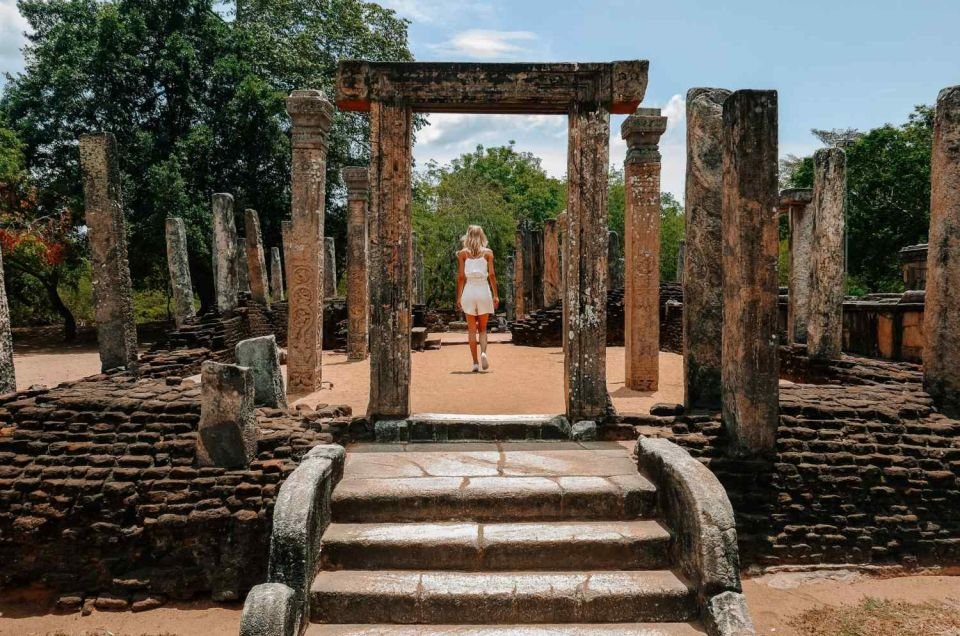
-
ROYAL PALACE
-
AUDIENCE HALL
-
SATHMAHAL PRASADAYA
-
NISSANKA LATHA MANDAPAYA
-
GAL POTHA STONE INSCRIPTION
-
POTHGUL VEHERA
-
NELUM POKUNA (LOTUS POND)
-
THE SACRED QUADRANGLE
-
PULATTHI STATUE
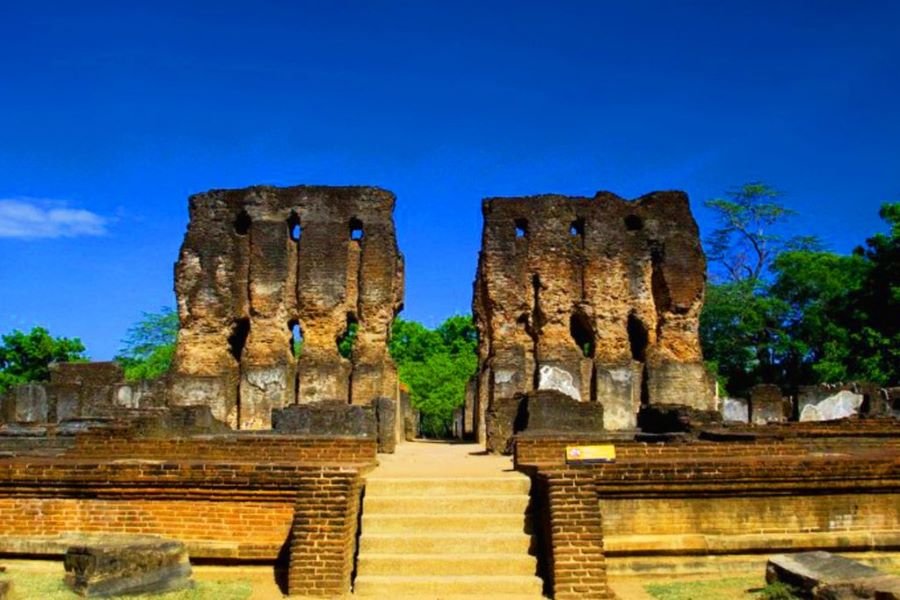
The Royal Palace of Polonnaruwa is an ancient structure located in the ancient city of Polonnaruwa, in the North Central Province of Sri Lanka. It was the residence of the King Parakramabahu I in the 12th century and is considered one of the finest examples of ancient Sinhalese architecture.
The palace complex consists of several structures, including the royal audience hall, council chamber, and living quarters for the king and his family. The buildings are constructed of brick, with ornate carvings and decorations, and are surrounded by a moat and ramparts.
The main audience hall of the palace is a large rectangular chamber, with a high roof supported by columns. The walls are decorated with intricate carvings of animals and mythological figures, and the ceiling is adorned with colorful paintings depicting scenes from Buddhist mythology.
Visitors to the Royal Palace can also explore the surrounding gardens, which were once filled with exotic plants and flowers. The palace is a popular destination for both tourists and locals, and is an important historical site for the people of Sri Lanka.
Overall, the Royal Palace of Polonnaruwa is a must-visit destination for anyone interested in the rich history and culture of Sri Lanka, and is a testament to the architectural and engineering skills of the ancient Sinhalese.
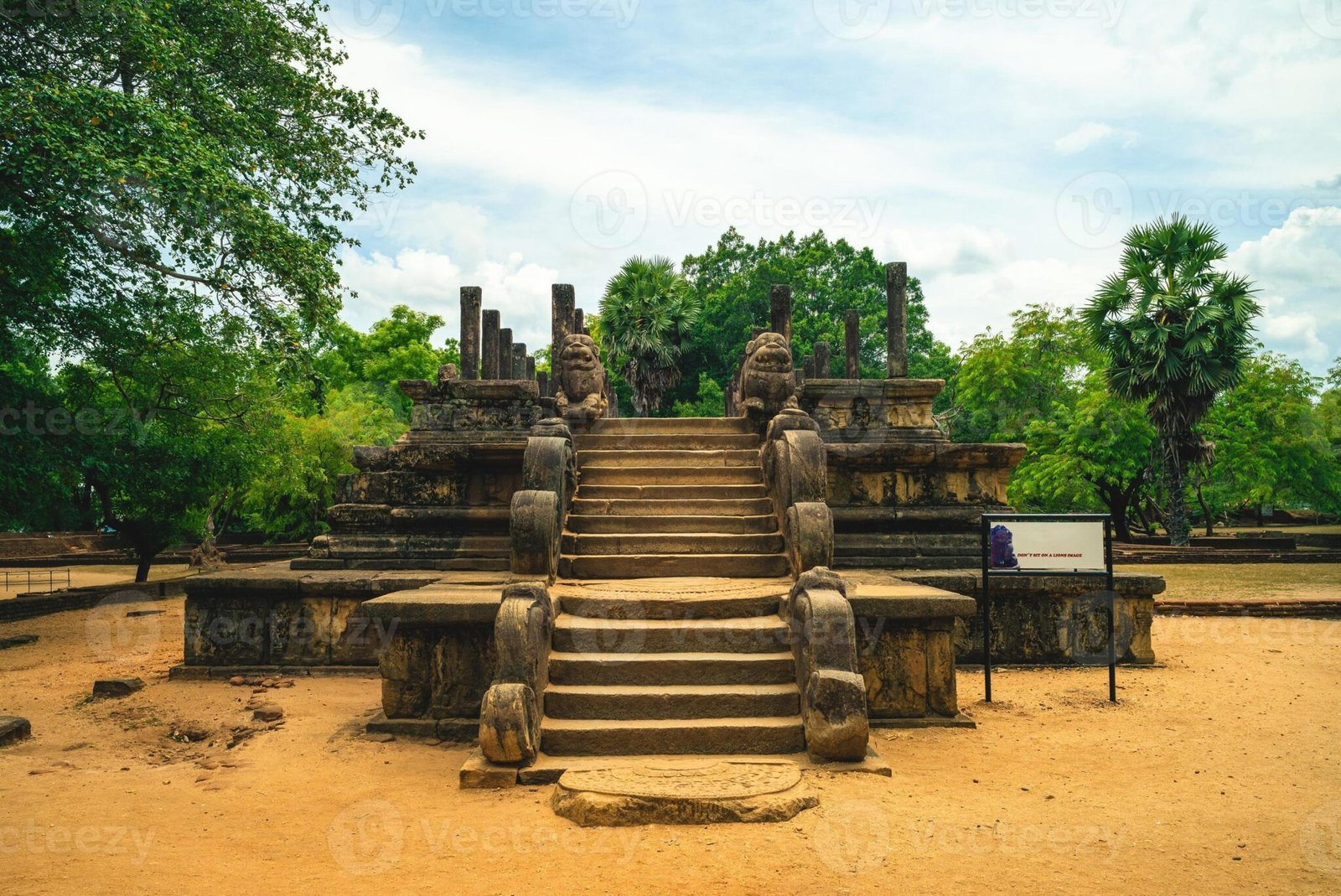
The Audience Hall in Polonnaruwa is an ancient structure located in the historic city of Polonnaruwa, in the North Central Province of Sri Lanka. It was built by King Parakramabahu I in the 12th century and is considered one of the most impressive examples of ancient Sinhalese architecture.
The Audience Hall was the place where the king would hold court and meet with his advisors and other important people. It is a large rectangular structure with a high roof supported by columns. The walls are decorated with intricate carvings of animals and mythological figures, and the ceiling is adorned with colorful paintings depicting scenes from Buddhist mythology.
The hall is surrounded by a moat and ramparts, which were designed to provide protection for the king and his court. Visitors to the Audience Hall can also explore the surrounding gardens, which were once filled with exotic plants and flowers.
The Audience Hall is a popular destination for tourists and locals alike, and is an important historical site for the people of Sri Lanka. It is a testament to the architectural and engineering skills of the ancient Sinhalese, and is a must-visit destination for anyone interested in the rich history and culture of Sri Lanka.
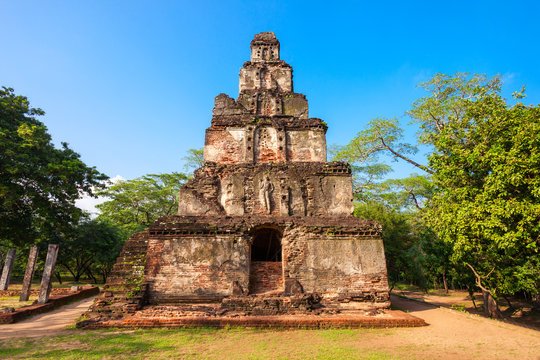
Sathmahal Prasadaya is a unique ancient building located in the Polonnaruwa District of North Central Province, Sri Lanka. The name Sathmahal Prasadaya means "Seven-story Palace" in Sinhalese, and it is a seven-storied brick building with a pyramid shape. The building's base is square-shaped, with sides measuring 35 feet. There are four doors with arches on each side, indicating that the building was accessible from all directions.
The purpose of Sathmahal Prasadaya is not entirely clear, but it is believed to have had religious or ceremonial functions. Its location within the Dalada Maluwa premises, a sacred complex in Polonnaruwa, suggests that it may have been used for important events or gatherings.
Sathmahal Prasadaya is a unique example of ancient Sri Lankan architecture and is considered a national treasure. It is an important cultural and historical site and attracts visitors from all over the world who come to appreciate its beauty and learn about its rich history.
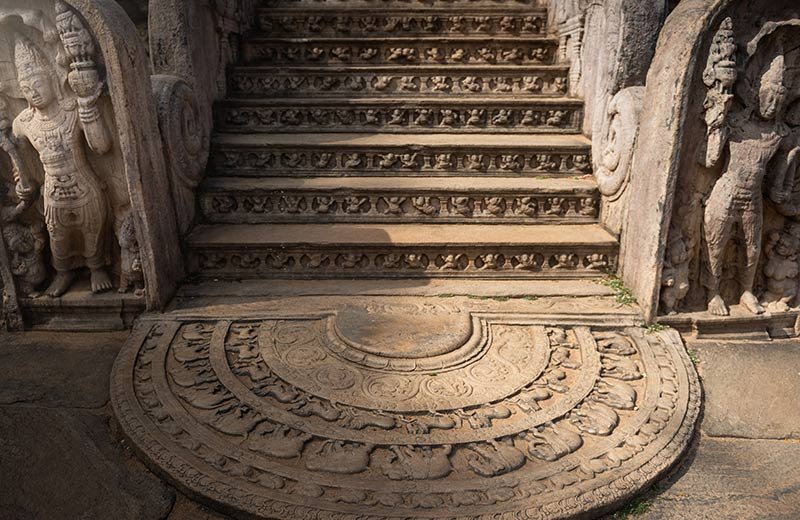
Nissanka Latha Mandapaya is an ancient building located in the ancient city of Polonnaruwa in Sri Lanka. It was built by King Nissanka Malla, who ruled Sri Lanka in the 12th century AD. The building is believed to have been used as a pavilion for the king's public audience and other royal ceremonies.
Nissanka Latha Mandapaya is a unique structure that features intricate carvings and sculptures. The building's name is derived from the ornate pillars that support the roof, which are carved to resemble the stems of a lotus flower. The pillars are intricately decorated with carvings of elephants, lions, and other animals, as well as intricate floral patterns and geometric designs.
The building's design is a fusion of Indian, Sinhalese, and Southeast Asian architectural styles. The roof of the building is made of wood and is supported by granite pillars, which is a typical feature of Sinhalese architecture.
Today, Nissanka Latha Mandapaya is considered an important historical and cultural site in Sri Lanka and is a popular tourist attraction. Visitors can appreciate the intricate carvings and sculptures and learn about the building's rich history and cultural significance.
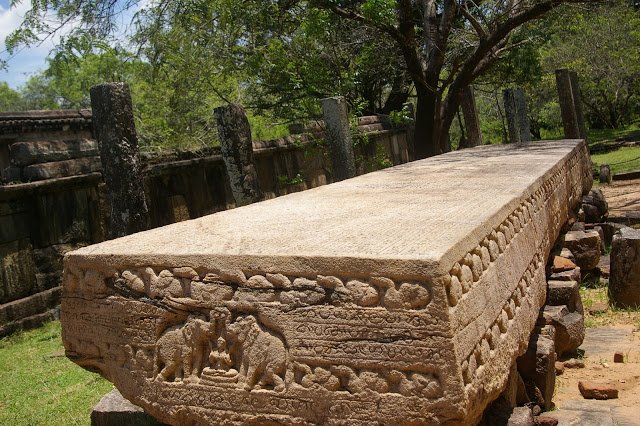
Gal Potha Stone Inscription is an ancient stone inscription located in the ancient city of Polonnaruwa in Sri Lanka. It was erected by King Nissanka Malla, who ruled Sri Lanka in the 12th century AD. The inscription is carved on a large granite slab, which measures approximately 26 feet in length and 4 feet in height.
The Gal Potha Stone Inscription is famous for its unique script, which is a combination of Sinhalese and Tamil languages. The inscription records the history and accomplishments of King Nissanka Malla and his reign, including his military campaigns, construction projects, and religious activities.
The inscription also includes detailed information about the taxes and fees imposed on the people of the kingdom, as well as the regulations for trade and commerce. This information provides valuable insights into the economic and social conditions of ancient Sri Lanka.
The Gal Potha Stone Inscription is considered an important historical document and a significant example of ancient Sri Lankan literature. It is also a popular tourist attraction and is visited by many visitors each year who come to appreciate its historical and cultural significance.
In recent years, the Gal Potha Stone Inscription has undergone restoration work to preserve its historical value for future generations.
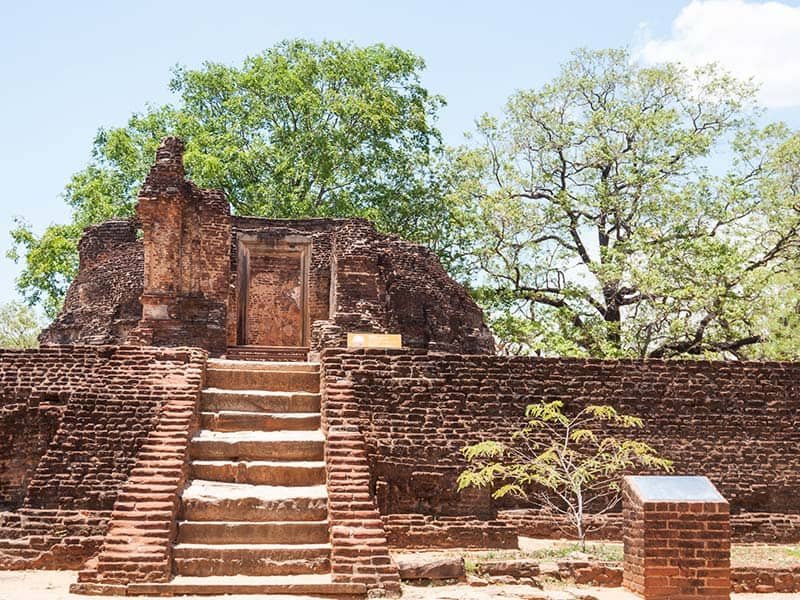
Pothgul Vehera is an ancient Buddhist temple located in the ancient city of Polonnaruwa in Sri Lanka. It is believed to have been built by King Nissanka Malla in the 12th century AD.
The temple's name, Pothgul Vehera, is derived from the Sinhalese words "Pothgul," which means book or scripture, and "Vehera," which means temple. The temple is named after the collection of ancient books and scriptures that were kept here in ancient times.
Pothgul Vehera is famous for its unique architectural features, including its circular shape and its two concentric walls. The temple's inner wall is adorned with intricate carvings and sculptures depicting scenes from the life of Buddha, as well as images of deities and other figures from Buddhist mythology.
The temple also features a circular platform with a statue of the Buddha seated in a meditative posture. This platform is surrounded by a circular walkway that allows visitors to circumambulate the statue.
Pothgul Vehera is considered an important historical and cultural site in Sri Lanka and is a popular tourist attraction. Visitors can appreciate the temple's unique architecture and intricate carvings, as well as learn about its rich history and cultural significance. The temple is also an important site for Buddhist pilgrims, who come to offer prayers and pay their respects to the Buddha.
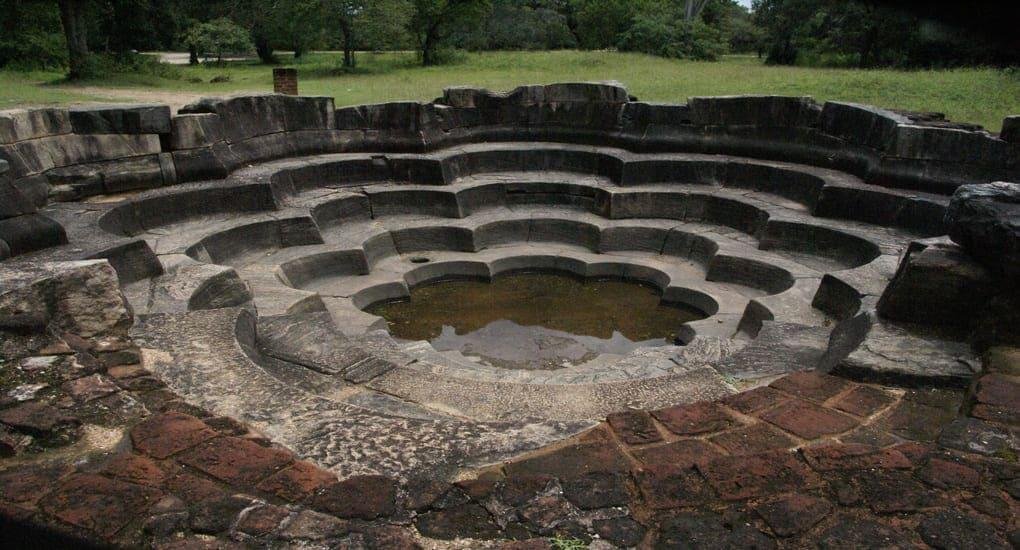
Nelum Pokuna, also known as the Lotus Pond, is an ancient water reservoir located in the ancient city of Polonnaruwa in Sri Lanka. The reservoir is believed to have been built by King Parakramabahu the Great in the 12th century AD.
The Nelum Pokuna reservoir is a large man-made pond that covers an area of approximately 22 acres. The pond is surrounded by a brick wall and features a series of steps leading down to the water's edge. The pond is also surrounded by a number of smaller structures, including a pavilion, a bathing house, and several small shrines.
The Lotus Pond is named after the lotus flowers that grow in the pond during the flowering season. The pond is also an important source of water for the surrounding area and is believed to have been used for irrigation and agriculture in ancient times.
Today, Nelum Pokuna is considered an important historical and cultural site in Sri Lanka and is a popular tourist attraction. Visitors can appreciate the pond's serene beauty and learn about its rich history and cultural significance. The pond is also an important site for religious ceremonies and festivals, particularly during the annual Esala Perahera festival, which is held in honor of the Tooth Relic of the Buddha.
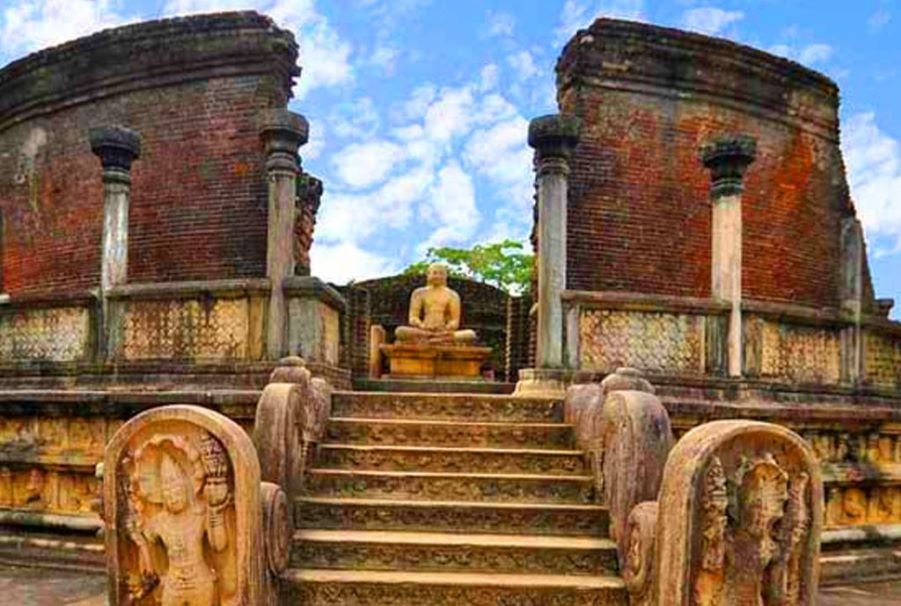
The Sacred Quadrangle is an important archaeological site located in the ancient city of Polonnaruwa in Sri Lanka. It is also known as the Dalada Maluwa, which means the "sacred ground of the tooth relic."
The Sacred Quadrangle is a large complex of temples and other structures that were built during the reign of King Parakramabahu the Great in the 12th century AD. The complex is laid out in a rectangular shape and is surrounded by a moat.
The most important structure in the Sacred Quadrangle is the Temple of the Tooth, which houses the relic of the tooth of the Buddha. The temple is a large brick structure with intricate carvings and sculptures depicting scenes from Buddhist mythology. The temple is considered one of the most sacred Buddhist sites in Sri Lanka and is visited by many pilgrims each year.
Other important structures in the Sacred Quadrangle include the Vatadage, a circular structure that was used to house the sacred tooth relic, and the Hatadage, a temple that was built to house a statue of the Buddha. The complex also includes several smaller temples, shrines, and other structures.
The Sacred Quadrangle is considered an important historical and cultural site in Sri Lanka and is a popular tourist attraction. Visitors can appreciate the complex's unique architecture and intricate carvings, as well as learn about its rich history and cultural significance. The site is also an important site for Buddhist pilgrims, who come to pay their respects to the sacred tooth relic.
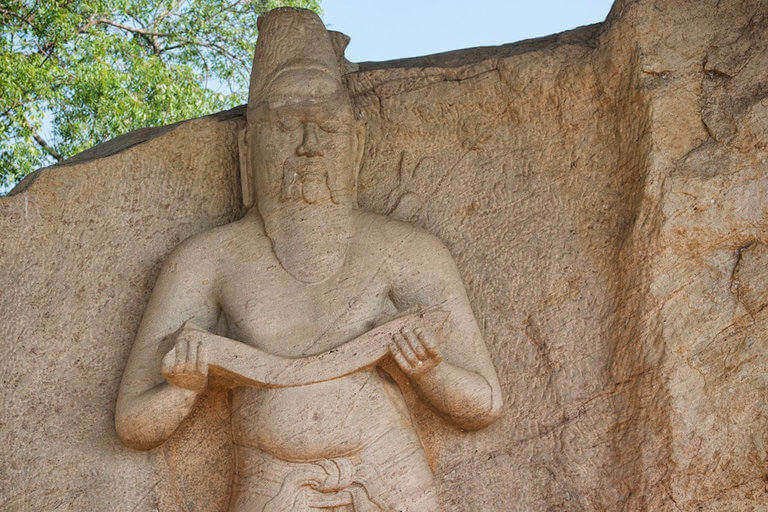
Situated in the southern outskirts, near the Pothgul Vihara, is a famous rock-cut sculpture of excellent quality. The correct interpretation of this statue still under discussion. Most Sinhalese people consider ot to be a portrait of Polonnaruwa's historically most important monarch, King Parakramabahu the Great. But the sacred thread running from the left shoulder across the body and the Ola palm leaf book carried in the hands are characteristics of Brahmin scholars. Some believe this statue to be a depiction of Rishi Kapila or Rishi Agastya. But most probably it's Rishi Pulastya, called Pulatthi in Pali or Pulasthi by locals. He is the name-giving patron of this city Polonnaruwa which in the Chulavamsa part of the Mahavamsa chronicle was called Pulatthinagara, meaning “Pulastya’s settlement”. Pulastya was the grandfather of the legendary king Ravana, who once was the mighty King of Lanka according the Indian Ramayana epic.
LET US PLAN YOUR PERFECT TRIP
Simply fill in the contact form below with the details of your request. One of our travel consultants will be in touch with you as soon as possible.

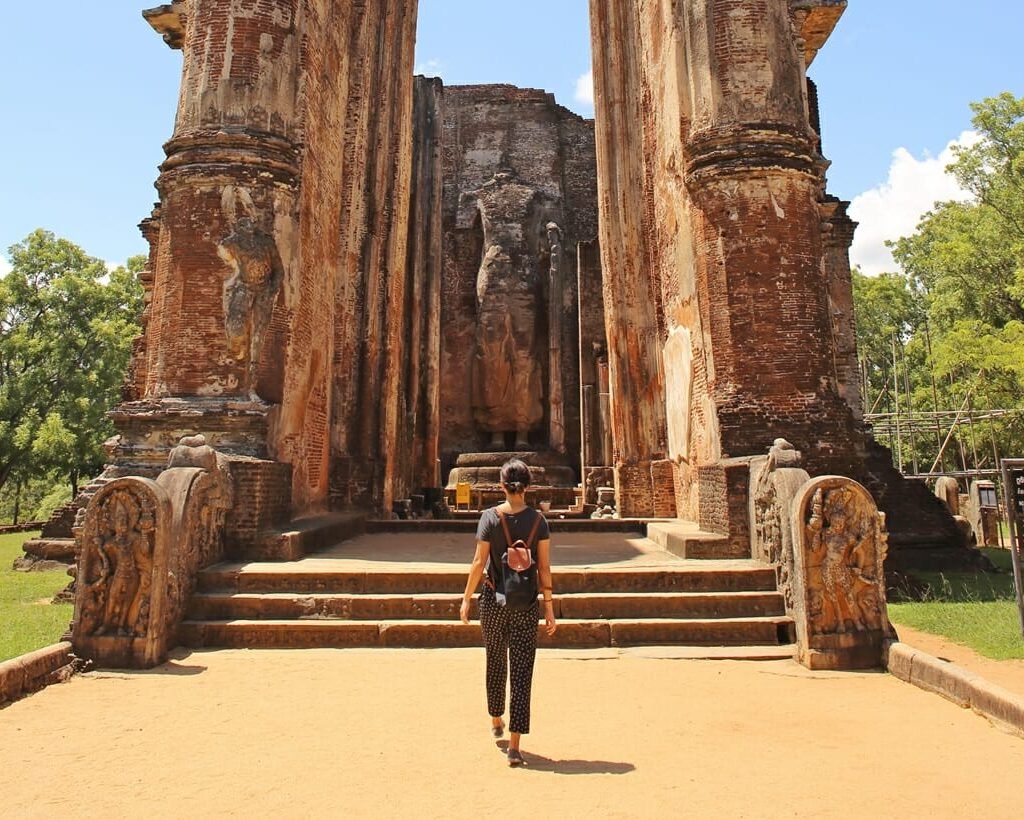
A passion for delivering awesome experiences
WHAT WE DO
Travel should be fun, easy and hassle free! That’s where we come in... let us plan everything for you from the moment you arrive until the minute you leave. Book that flight and leave the rest to us!
Contact Us: +94761606059
Web – https://travellerinsider.com
Email: info@travellerinsider.com
